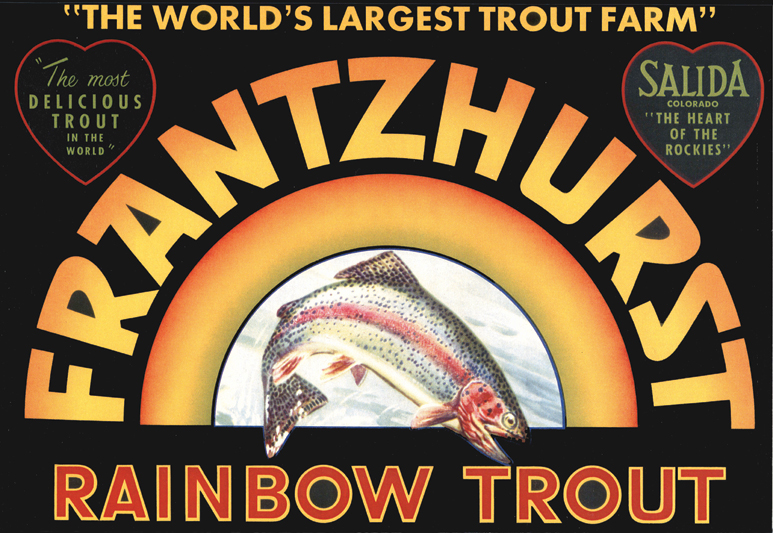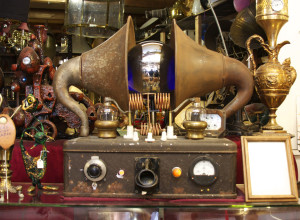Chaffee County Historic Resources Survey Series
By Fay Golson for The Chaffee County Heritage Area Advisory Board
The Frantzhurst Rainbow Trout Hatchery is the ninth property featured from the Chaffee County Historic Resources Survey. The trout farm, once labeled the “largest trout operation in the world,” continues to operate as a state-run fish hatchery. It is located approximately a half-mile northwest of Salida off Colo. 291. The hatchery’s annual production is about two million trout, which are used to stock Colorado’s many streams and lakes.
 The early western pioneers had no catch limits on fish, causing the once abundant fish populations to dwindle. In 1870, this problem was addressed in fish studies, prompting the formation of fish spawning stations. Their job was to collect and hatch fish eggs that, once hatched, were released back into the waters. Some of these fish stations grew to become hatcheries, and the Fisheries Program and the National Fish Hatchery System were founded. In 1871, Ulysses S. Grant established the U.S. Fish Commission, which later became the U.S. Fish and Wildlife Service. Early shipment of fish was often in milk cans via horse and wagon. The U.S. Fish and Wildlife Service reports, “State-of-the-art shipments were done via train car. In 1881, federally raised fish traveled first-class in rail cars designed for their health and comfort – along with their human attendants.”
The early western pioneers had no catch limits on fish, causing the once abundant fish populations to dwindle. In 1870, this problem was addressed in fish studies, prompting the formation of fish spawning stations. Their job was to collect and hatch fish eggs that, once hatched, were released back into the waters. Some of these fish stations grew to become hatcheries, and the Fisheries Program and the National Fish Hatchery System were founded. In 1871, Ulysses S. Grant established the U.S. Fish Commission, which later became the U.S. Fish and Wildlife Service. Early shipment of fish was often in milk cans via horse and wagon. The U.S. Fish and Wildlife Service reports, “State-of-the-art shipments were done via train car. In 1881, federally raised fish traveled first-class in rail cars designed for their health and comfort – along with their human attendants.”
Horace G. Frantz was born April 1891 in Wilmington, Delaware where his father, Dr. Jacob F. Frantz, practiced dentistry. The Frantz family moved to New York City, and Dr. Frantz became the president of the Dentists’ Supply Company of New York and director of numerous other corporations. Horace was one of five children: two girls and three boys. To foster his recovery from tuberculosis, sixteen year old Horace moved to Colorado Springs. Fully recovered, he served in World War I as a Naval Air Corps pilot. After the war, he returned to Colorado Springs and worked as a fish culturist at his first fish farm. During this time, he was informed of a fish hatchery for sale in Salida. The Front Range Research Associates (FRRA) reports, “A mailman in Colorado Springs told him that the remarkable springs in Salida made the area a good place for a trout farm.
The Salida trout farm was established by Robert Bruce in 1918. In a 2013 letter to the hatchery from daughter Helen Bruce Corbin. She writes, “My dad owned the fish hatchery … My mother and dad lived there three or four years and I was born there in 1921. My mother died when I was just two weeks old. My dad was left with a five-year-old boy and a four-year-old girl (as well as infant Helen). He sold the fish farm and moved to Topeka, Kansas where his sister lived.” In September 1925, Frantz purchased this property, containing an existing fish hatchery, for $11,500. Frantz transferred ownership to the Frantzhurst Rainbow Trout Company in December 1925 and erected a log building which served as home for the family. Horace Sr. and his wife, Genevieve, had two children, both born in Colorado: Horace C. Jr. and Marcia L. (For an informative article by Susan Bavaria about the Frantzhurst Rainbow Trout Hatchery refer to the July 2010 issue of Colorado Central, Bavaria indicates that it was Genevieve who added preeminence to the name by including the suffix “hurst.”)
Trout was not the only interest of Horace Sr. The raising of silver fox, mink, and Chinchilla rabbits, as well as numerous other ventures, kept Horace Sr. immersed in work. However, the hatchery was the long- running endeavor. He operated the hatchery from the mid-1920s until about 1950.
 Many articles have been written about the hatchery, including a six-page spread in a 1948 issue of The Saturday Evening Post. According to Bavaria, after the publication of this article, “Advertising agent J. Walter Thompson contacted Frantz, Sr. with a letter of inquiry whether or not his business used Ford trucks. Frantz St. responded that he had used Ford products for more than 22 years … It wasn’t long before J. Walter Thompson had a camera crew out at Frantz’s trout farm to film the Ford truck print magazine fall campaign.” The Post article also caught the attention of Twentieth Century Fox, and soon Hollywood celebrities arrived to amplify their publicity efforts. In an interview by V Magazine, Horace Jr. remarks, “They would come to the farm, stay overnight and sleep in our guest room. Many members of the Associated Press and United Press International would come and talk to them while they were there.” The celebrity list included Betty Gable, Dinah Shore, Shirley Temple and, from Abbott and Costello films, Hillary Brooke. Black-and-white autographed photographs once hung on a wall inside the log home. The photos now hang inside the hatchery main office.
Many articles have been written about the hatchery, including a six-page spread in a 1948 issue of The Saturday Evening Post. According to Bavaria, after the publication of this article, “Advertising agent J. Walter Thompson contacted Frantz, Sr. with a letter of inquiry whether or not his business used Ford trucks. Frantz St. responded that he had used Ford products for more than 22 years … It wasn’t long before J. Walter Thompson had a camera crew out at Frantz’s trout farm to film the Ford truck print magazine fall campaign.” The Post article also caught the attention of Twentieth Century Fox, and soon Hollywood celebrities arrived to amplify their publicity efforts. In an interview by V Magazine, Horace Jr. remarks, “They would come to the farm, stay overnight and sleep in our guest room. Many members of the Associated Press and United Press International would come and talk to them while they were there.” The celebrity list included Betty Gable, Dinah Shore, Shirley Temple and, from Abbott and Costello films, Hillary Brooke. Black-and-white autographed photographs once hung on a wall inside the log home. The photos now hang inside the hatchery main office.
The log building consists of a two-story section to the west, joined by a one story connector to another two-story section to the east acting as garage/dormitory. The building is significant in the area of architecture with its Rustic Style and agriculture for playing a critical role in the trout hatchery operation. It is significant for its association with Horace Frantz, Sr., a man who was instrumental in the operation. As stated by FRRA regarding the house, “While a fish hatchery is still operated on the larger parcel by the State of Colorado, this building and its pond to the west may be the best representatives of the Frantzhurst era remaining.”
Fay Golson is a preservationist, artist and aspiring writer living in Chaffee County, an area brimming with historic resources. She has authored several National Register of Historic Places Nominations and now can be found in her Salida art studio or among the stacks at the Salida Regional Library, frantically searching for historic references.



